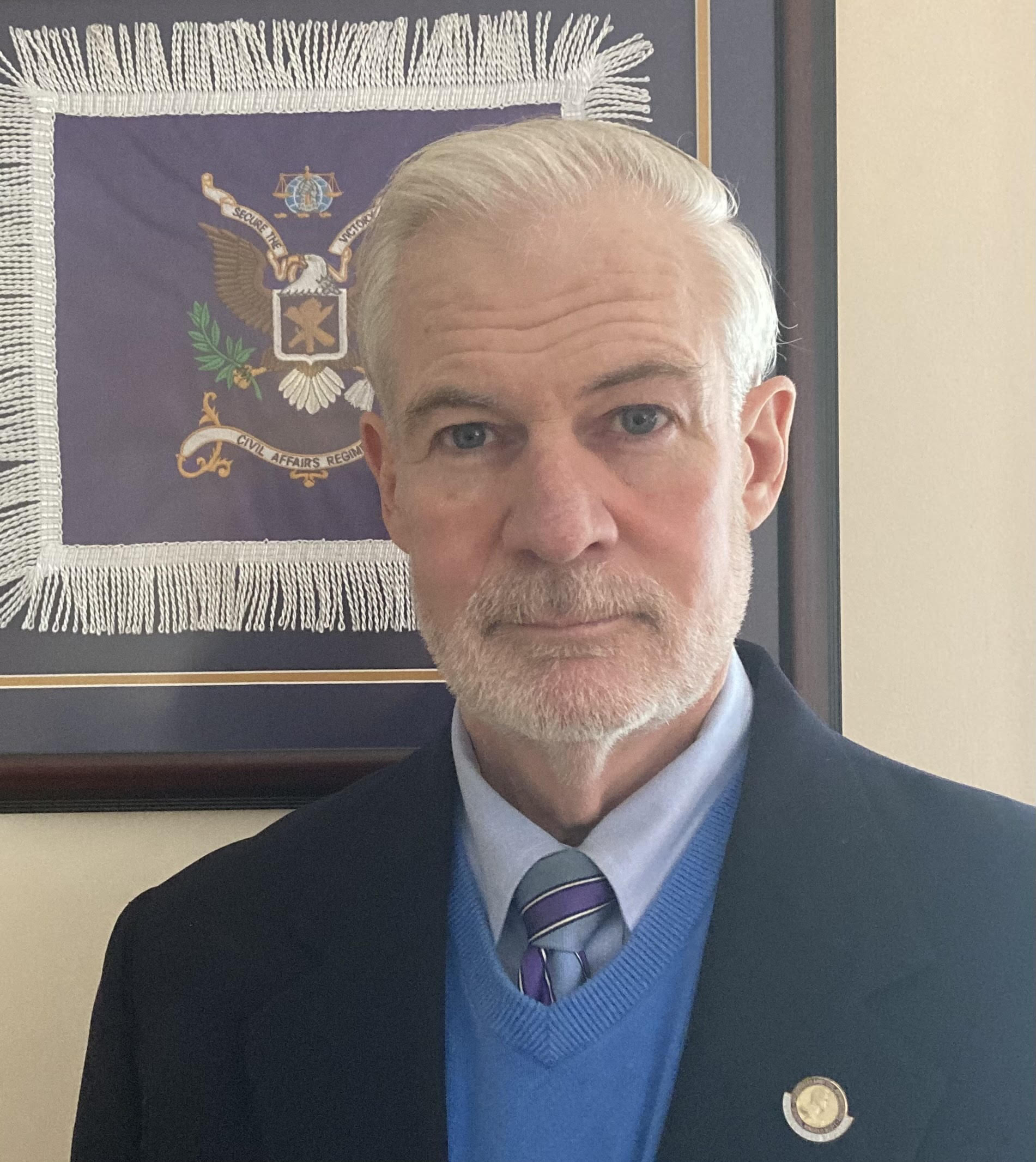9-minute read
The answer to this question is found in U.S. Army regulations (ARs) and Army General Orders (AGOs). However, since few have seen these sources, let’s take a few minutes to review them.
The U.S. Army Regimental System (USARS).
The first reference we must be familiar with is AR 870-21, “The U.S. Army Regimental System,” 11 December 2023, with an administrative revision effective 25 January 2024.
An excerpt from Chapter 2 of AR 870-21 (formerly AR 600-82) explains the origin of the USARS. The bold and underlined fonts are my emphasis.
“Between 1957 and 1959, the Army eliminated the regimental headquarters as a tactical and administrative organization from most of its combat arms regiments (except some cavalry regiments). However, the Army was determined to retain the history, traditions, and ceremonial function of the regiment in the new structure. The result was the Combat Arms Regimental System designed to allow perpetuation of combat arms regimental history, ceremony, and traditions in the new tactical organizations without restricting the organizational innovations of the future. In 1984, the Combat Arms Regimental System was expanded to include the non-combat arms branches with the advent of USARS. Under USARS, non-combat arms branches were incorporated under the “whole-branch” concept in which the entire branch corps provided a regimental model historical bond. USARS provides Soldiers with a sense of tradition and a connection to the past, while continuing to enable the Army to evolve and adapt to current and future requirements. In short, the USARS bridges the traditional role of the regiment with the tactical mission of the modern Army.
…USARS provides each current and former Soldier continuous identification with a regiment, a corps, or a special branch. The USARS mission is to enhance Army esprit de corps and pride, as well as impart a keen understanding of its past, through a framework that provides the opportunity for affiliation, develops loyalty and commitment, fosters an extended sense of belonging, improves unit cohesion, and institutionalizes an Army ethos…”
Chapter 3 defines regiments:
“For the purposes of this regulation, combat arms branches are defined as Air Defense Artillery, Armor, Aviation, Cavalry, Field Artillery, Infantry, and Special Forces. Regiments serve as the basis for branch traditions and heritage. Within the combat arms branches, units consist of numbered regiments with subordinately numbered battalions or squadrons and lettered companies, troops, batteries, or numbered Special Forces groups.”
Chapter 4 defines corps and special branches:
“For purposes of this regulation, the following conventions apply to corps and special branches:
a. Corps and special branch traditions are based on the history and heritage of each branch.
b. While the corps and special branches do not currently include numbered regiments, they provide a source of pride and cohesion to Soldiers and Department of Army Civilians not otherwise affiliated with a regiment, and thus serve the same purpose as the numbered regiments in the combat arms branches.
c. Corps and special branches, and their chiefs of corps, are listed in table 4–1; custodial responsibilities are enumerated in paragraph 6–2.
d. For the purposes of this regulation corps, special branches, and whole branch regiments are one in the same.”
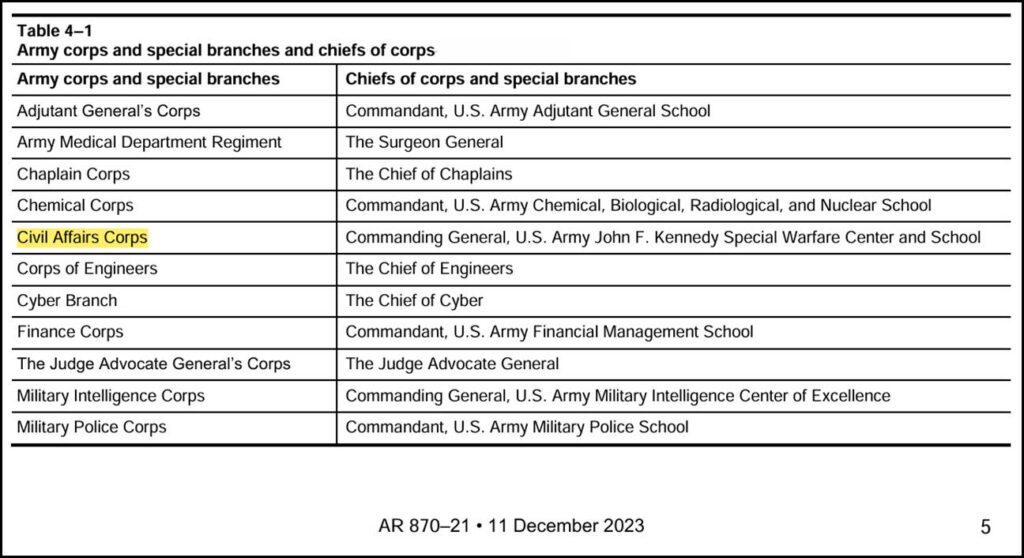
The establishment of the U.S. Army Reserve Civil Affairs Corps.
While non-combat arms branches first came under the USARS in 1984,it took several years for the CA branch proponent, in coordination with the Center of Military History (CMH) and the Institute of Heraldry (IOH), to establish the branch within the system with a distinctive standard and insignia. This is evident in the implementation memorandum dated 20 March 1989, below.

On 1 June 1989, Headquarters, Department of the Army, published AGO 1989-22, establishing the U.S. Army Reserve (USAR) Civil Affairs Corps. At that time, as described in CATR Post #10, CA was a branch within the USAR only. Since CA was a functional area and not a branch in the Regular Army, Soldiers of the 96th CA Battalion (Airborne), the Army’s only active component CA unit at that time, could not affiliate with the USAR CA Corps. They could only affiliate with the regiment or corps authorized for their branch or military occupational specialty.
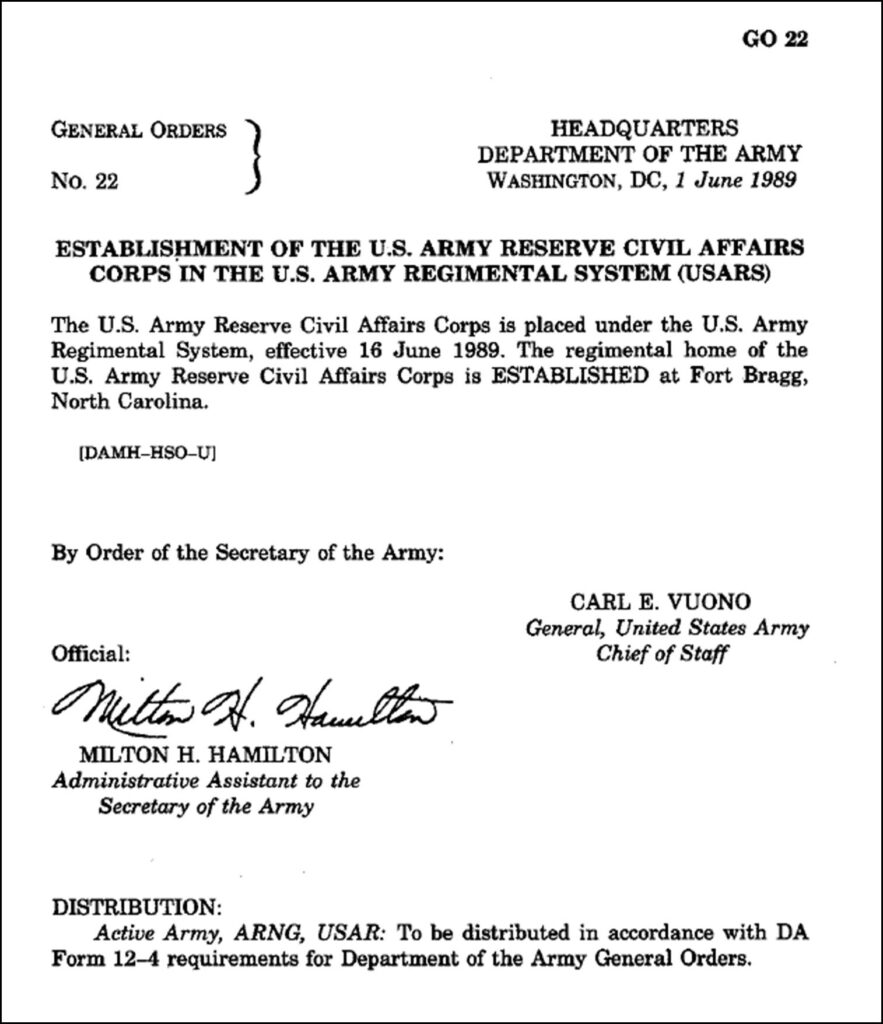
This excerpt from the Congressional Record demonstrates that an activation ceremony for the USAR CA Corps did take place on June 16, 1989, in Pensacola, FL, during the annual Civil Affairs Association (CAA) Conference. Since then, the CAA, founded by CA Veterans of World War II in 1947, has continuously supported the CA Corps in various ways.
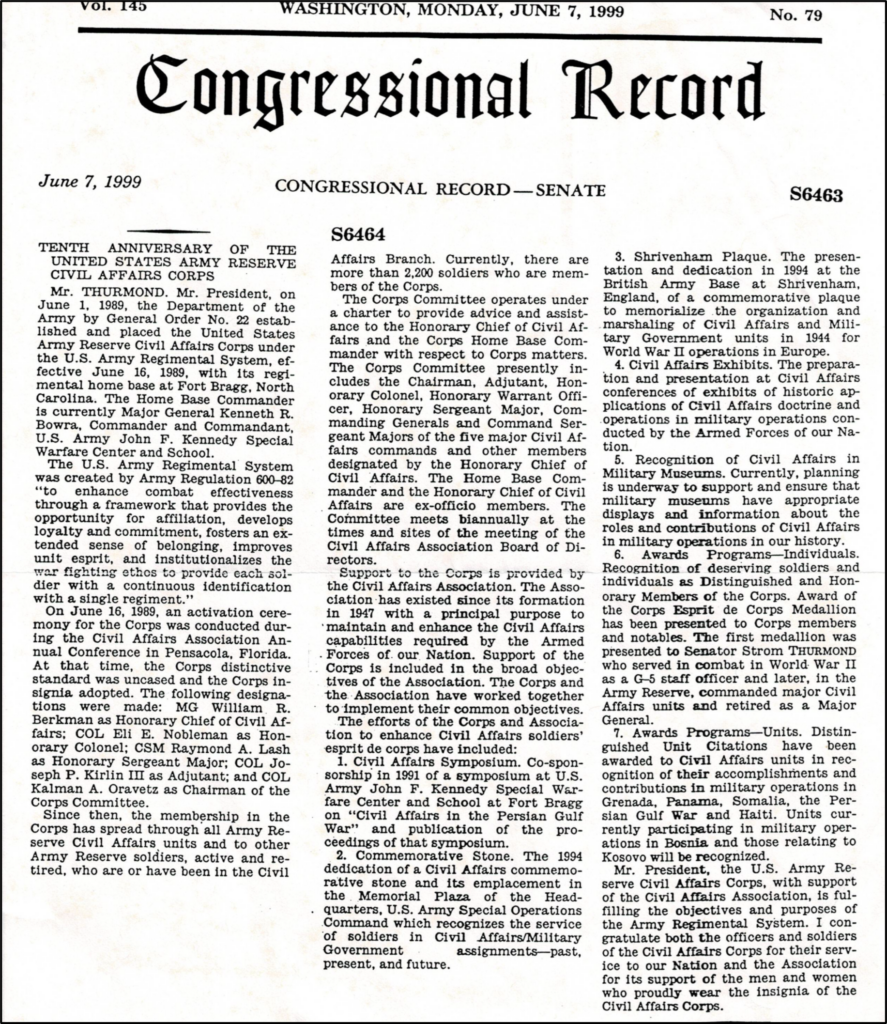
Change to the U.S. Army Civil Affairs Corps.
As detailed in CATR Post #10, CA was officially established as a branch of the Regular Army on 16 October 2006. In anticipation of this action, the Army renamed the U.S. Army Reserve Civil Affairs Corps to the U.S. Army Civil Affairs Corps, effective 16 June 2004. Soldiers in the active component could now join the new branch through reclassification or by completing the new branch-producing courses at USAJFKSWCS.
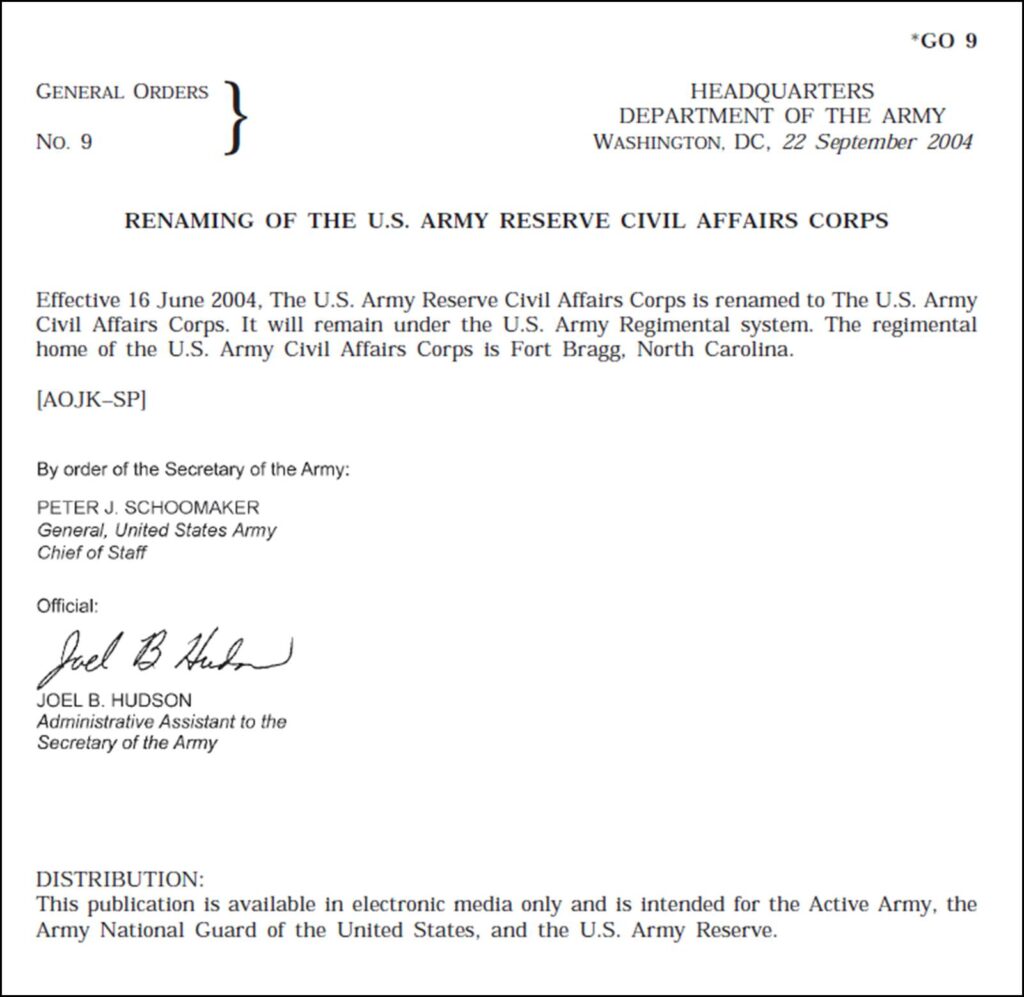
Why do some call it a Regiment?
I don’t remember hearing the term “civil affairs regiment” until after the U.S. Army Civil Affairs and Psychological Operations Command (Airborne) (USACAPOC(A)) headquarters and all USAR CA and PSYOP units were realigned under U.S. Army Forces Command (FORSCOM). When that happened in 2006, the 95th CA Brigade (Special Operations)(Airborne) and the 4th PSYOP Group became direct reporting units (DRUs) to U.S. Army Special Operations Command (USASOC).
I believe the USASOC headquarters was mainly influenced by active and retired special forces (SF) Soldiers affiliated with the special forces regiment. More than likely, they transitioned to SF from a combat arms branch where they were previously associated with a regiment under the USARS. Additionally, they worked closely with elements of the 75th Ranger Regiment and the 160th Special Operations Aviation Regiment.
It’s human nature – or definitely Army nature – to simplify things. (“Keep it simple, Soldier” is just one of many versions of the KISS principle.) It’s easier to say, “the three regiments” instead of “the SF and PSYOP Regiments and the CA Corps,” or “the ARSOF regiments and corps” when talking about the three “tribes” (another euphemism) of CA, PSYOP, and SF. (By the way, the second half of Table 4-1 on page 6 of AR 870-21 names the psychological operations branch as a regiment, even though it is not a combined arms branch. I couldn’t find a clear reason for this designation, not even on the Psychological Operations Veterans Association’s website.)
Of course, what I didn’t realize until I searched the CAA Archives for background materials for this post is that the term “Civil Affairs Regiment” was used before 2006. As mentioned earlier, the CA Corps was activated in a ceremony on 16 June 1989, in Pensacola, FL, during the annual CAA Conference. A page from the program of the 42nd Annual Conference, held 14-18 June 1989, clearly shows the term Regiment used three times in the description of the new distinctive insignia.

However, on a previous page, the conference agenda included the following entry for Friday, 16 June 1989, from 10:30-11:30: “REGIMENTAL ACTIVATION CEREMONY FOR THE CIVIL AFFAIRS CORPS.”
In a separate document titled, “SELECTED HIGHLIGHTS, ANNUAL CONFERENCE OF THE CIVIL AFFAIRS ASSOCIATION CONFERENCE, JUNE, 1989,” the author reports, “The Civil Affairs Regiment was formally created in a very appropriate ceremony. An interim policy and procedure for joining the Regiment utilizing Form 4187 with appropriate attached documentation will be sent to the units.” That procedure was later distributed to all USAR CA units in a 17 May 1990 memorandum from Headquarters, United States Army Reserve Special Operations Command (Airborne) at Fort Bragg (the predecessor of USACAPOC(A)). With the subject, “Letter of Instruction for USAR Civil Affairs Corps Affiliation,” it properly outlined how to affiliate with the USAR Civil Affairs Corps under the U.S. Army Regimental System.
As a writer and editor who values accuracy and consistency, I am disappointed by the inaccurate and inconsistent use of the word Regiment in the 1989 documents and in more recent references since 2006 – especially in light of AGO 2004-09 depicted above. This is particularly true for any version of the regimental colors purchased at local sewing shops around Fort Bragg that display the incorrect wording, “Civil Affairs Regiment” instead of “Civil Affairs Corps,” which, unfortunately, includes the one on display at the Civil Affairs Branch Proponent at USAJFKSWCS.
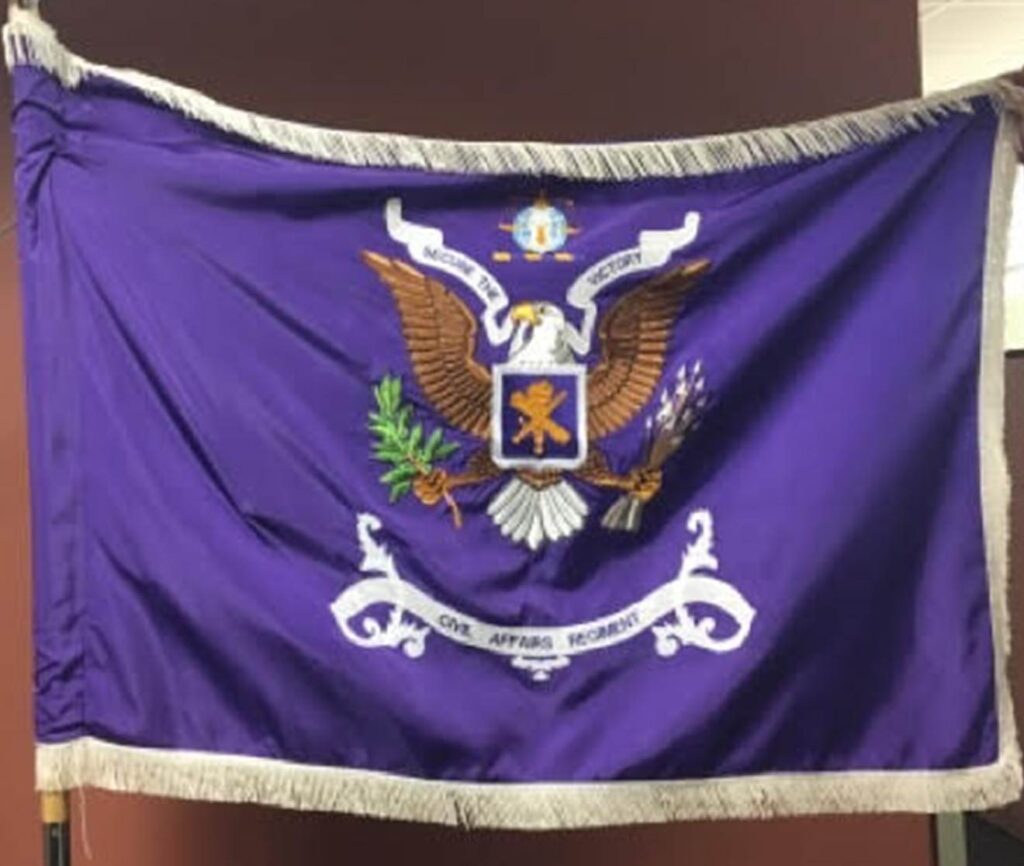
What about the Honorary and Distinguished Titles and Positions?
AR 870-21 details honorary and distinguished titles for both regiments and corps. “The Honorary Colonels, Honorary Warrant Officers, Honorary Sergeants Major, and Distinguished Members of the regiment or corps provide a link with history for today’s Soldiers.” It further describes each of these roles for both regiment and corps, e.g., “Honorary Colonel of the Regiment (HCOR) or Honorary Colonel of the Corps (HCOC)… HWOOR or HWOOC… HSGMOR or HSGMOC… DMOR or DMOC… HMOR or HMOC.”
Early in the Corps’ history, despite issues with the activation documents, the CA Corps used the correct terms. Page 1 of an undated Charter for the Regimental Committee of the Civil Affairs Corps confirms this.
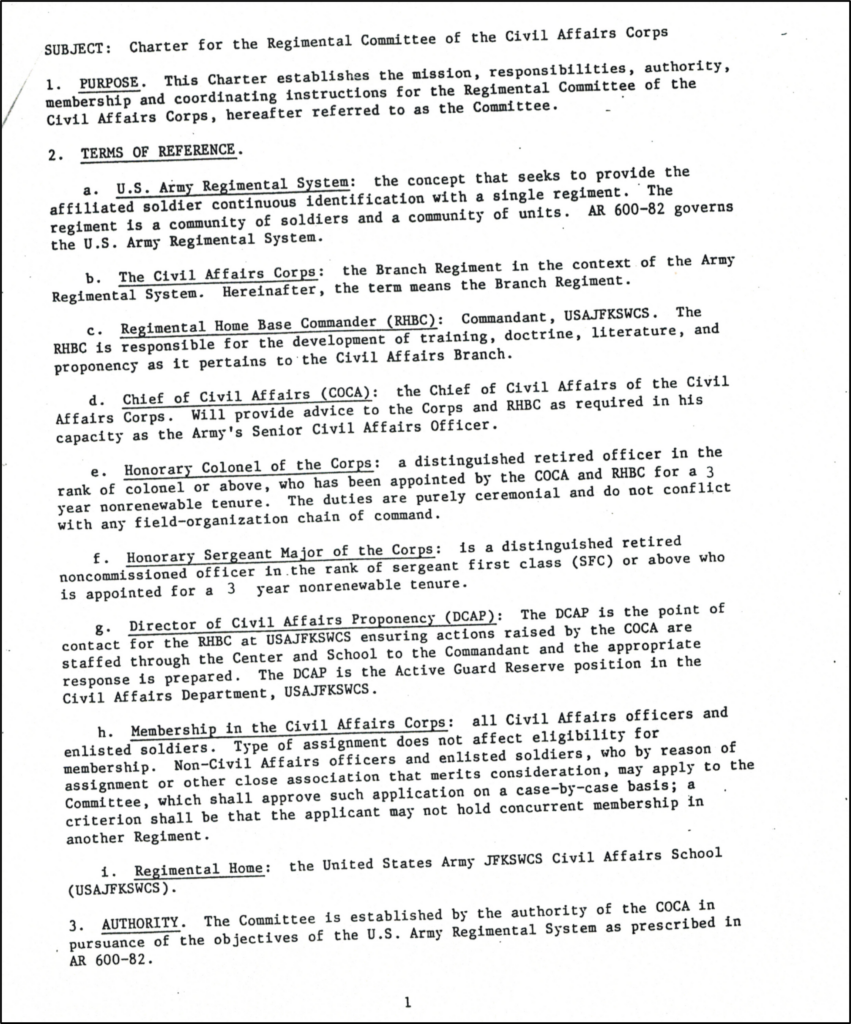
Likewise, an undated paper titled “TEN YEARS OF ACCOMPLISHMENTS BY THE UNITED STATES ARMY RESERVE CIVIL AFFAIRS CORPS,” states:

The USAJFKSWCS now outlines the Regimental Honors, Awards, and Affiliations Program for the Special Forces Regiment, the Psychological Operations Regiment, and the Civil Affairs Corps in USAJFKSWCS Regulation 870-21. The latest DRAFT version of that regulation mentions the “Civil Affairs Corps” twice in the Commanding General’s opening remarks. However, it also includes a note stating, “Throughout this regulation, the ‘CA Corps’ is referred to as a ‘Regiment.’” It further clarifies that the civil affairs recipients of those honorary titles are exclusively called HCOR, HSGMOR, DMOR, and HMOR. Once it is published, we will review this regulation to see if this wording survives final review and approval by the USAJFKSWCS CG.
As a DMOR and former HCOR, and since I couldn’t get the system to change, I chose to resolve the discrepancy by identifying myself as a Distinguished Member of the Regiment for the Civil Affairs Corps and a past Honorary Colonel of the Regiment for the Civil Affairs Corps. USAJFKSWCS maintains a list of the Distinguished and Honorary Members of the Regiment for the Civil Affairs Corps here.
Questions for our teammates: Does this sufficiently answer the question? Are the images of source documents helpful?
Send a note to the Civil Affairs Team Room.
Subscribe for updates to the Civil Affairs Team Room Blog

